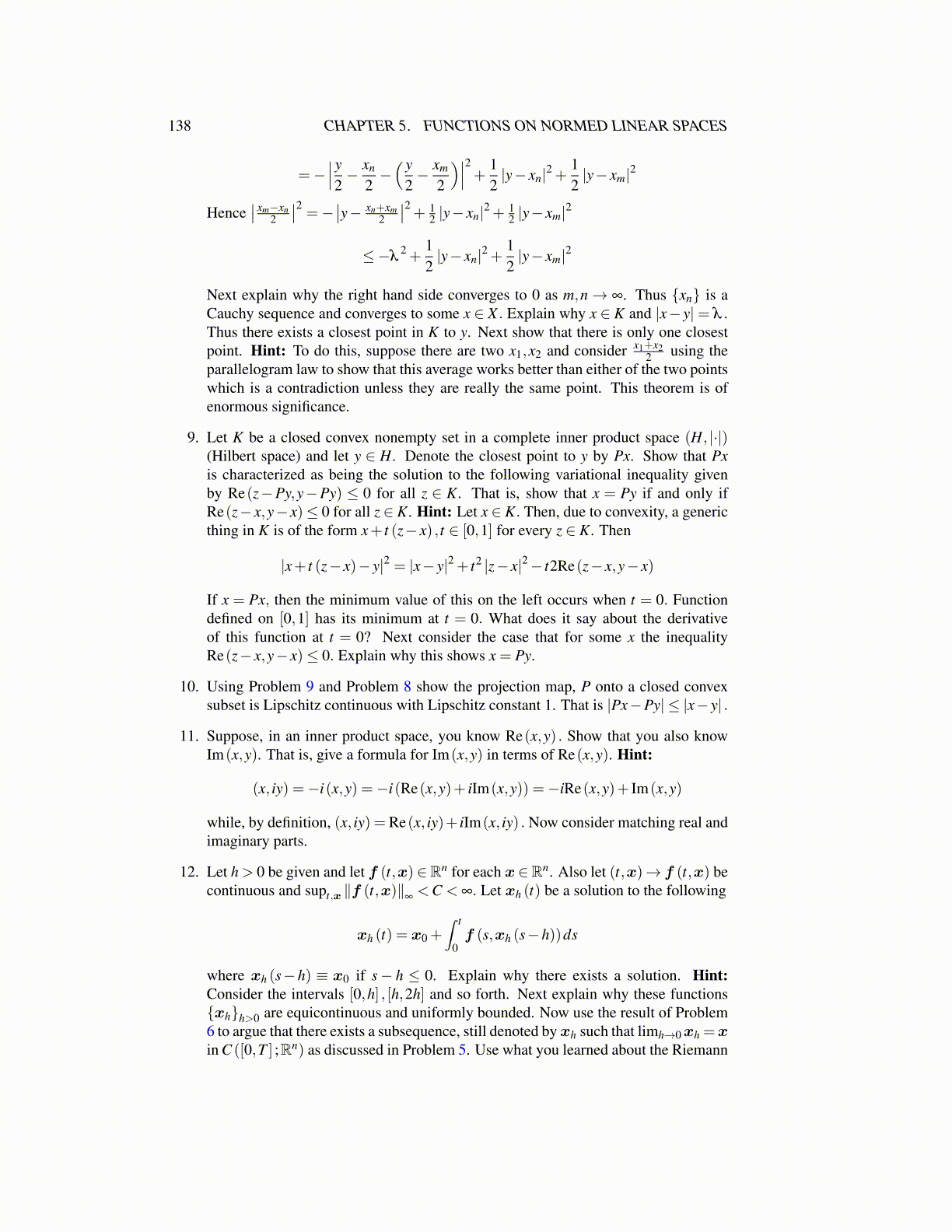
138 CHAPTER 5. FUNCTIONS ON NORMED LINEAR SPACES
=−∣∣∣ y2− xn
2−( y
2− xm
2
)∣∣∣2 + 12|y− xn|2 +
12|y− xm|2
Hence∣∣ xm−xn
2
∣∣2 =− ∣∣y− xn+xm2
∣∣2 + 12 |y− xn|2 + 1
2 |y− xm|2
≤−λ2 +
12|y− xn|2 +
12|y− xm|2
Next explain why the right hand side converges to 0 as m,n→ ∞. Thus {xn} is aCauchy sequence and converges to some x ∈ X . Explain why x ∈ K and |x− y|= λ .Thus there exists a closest point in K to y. Next show that there is only one closestpoint. Hint: To do this, suppose there are two x1,x2 and consider x1+x2
2 using theparallelogram law to show that this average works better than either of the two pointswhich is a contradiction unless they are really the same point. This theorem is ofenormous significance.
9. Let K be a closed convex nonempty set in a complete inner product space (H, |·|)(Hilbert space) and let y ∈ H. Denote the closest point to y by Px. Show that Pxis characterized as being the solution to the following variational inequality givenby Re(z−Py,y−Py) ≤ 0 for all z ∈ K. That is, show that x = Py if and only ifRe(z− x,y− x)≤ 0 for all z ∈ K. Hint: Let x ∈ K. Then, due to convexity, a genericthing in K is of the form x+ t (z− x) , t ∈ [0,1] for every z ∈ K. Then
|x+ t (z− x)− y|2 = |x− y|2 + t2 |z− x|2− t2Re(z− x,y− x)
If x = Px, then the minimum value of this on the left occurs when t = 0. Functiondefined on [0,1] has its minimum at t = 0. What does it say about the derivativeof this function at t = 0? Next consider the case that for some x the inequalityRe(z− x,y− x)≤ 0. Explain why this shows x = Py.
10. Using Problem 9 and Problem 8 show the projection map, P onto a closed convexsubset is Lipschitz continuous with Lipschitz constant 1. That is |Px−Py| ≤ |x− y| .
11. Suppose, in an inner product space, you know Re(x,y) . Show that you also knowIm(x,y). That is, give a formula for Im(x,y) in terms of Re(x,y). Hint:
(x, iy) =−i(x,y) =−i(Re(x,y)+ iIm(x,y)) =−iRe(x,y)+ Im(x,y)
while, by definition, (x, iy) = Re(x, iy)+ iIm(x, iy) . Now consider matching real andimaginary parts.
12. Let h > 0 be given and let f (t,x)∈Rn for each x∈Rn. Also let (t,x)→ f (t,x) becontinuous and supt,x ∥f (t,x)∥
∞<C < ∞. Let xh (t) be a solution to the following
xh (t) = x0 +∫ t
0f (s,xh (s−h))ds
where xh (s−h) ≡ x0 if s− h ≤ 0. Explain why there exists a solution. Hint:Consider the intervals [0,h] , [h,2h] and so forth. Next explain why these functions{xh}h>0 are equicontinuous and uniformly bounded. Now use the result of Problem6 to argue that there exists a subsequence, still denoted by xh such that limh→0xh =xin C ([0,T ] ;Rn) as discussed in Problem 5. Use what you learned about the Riemann